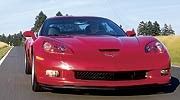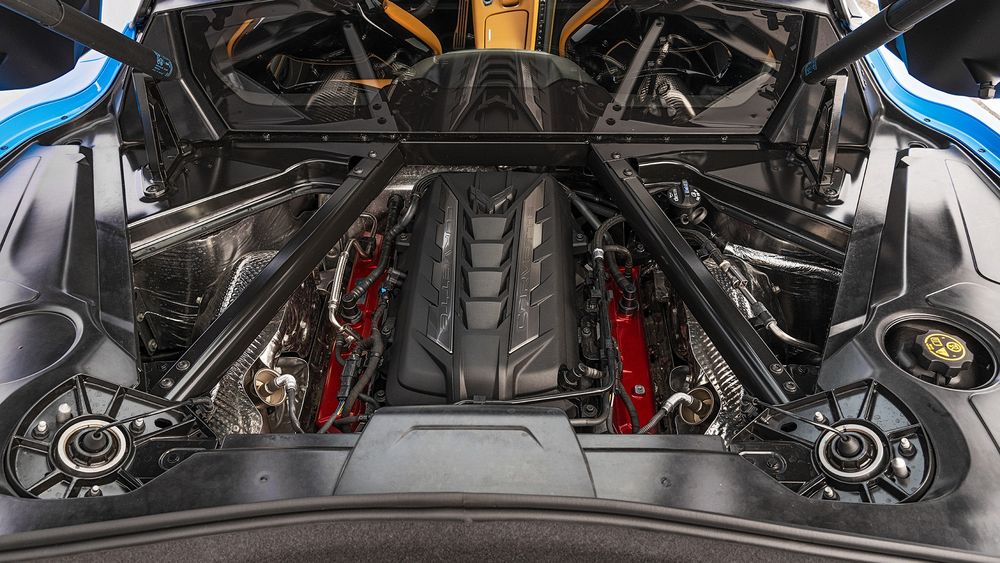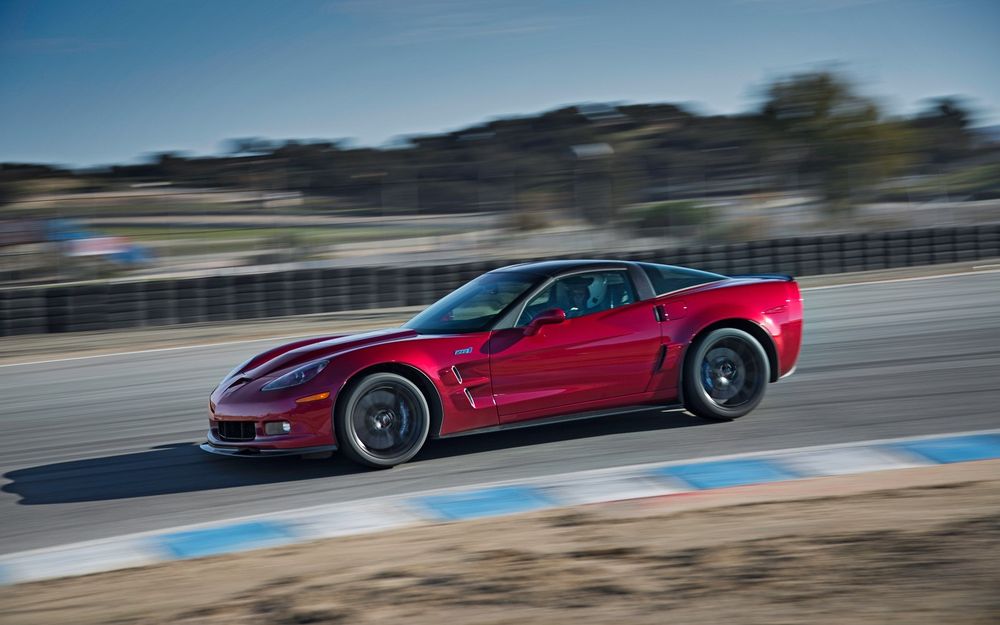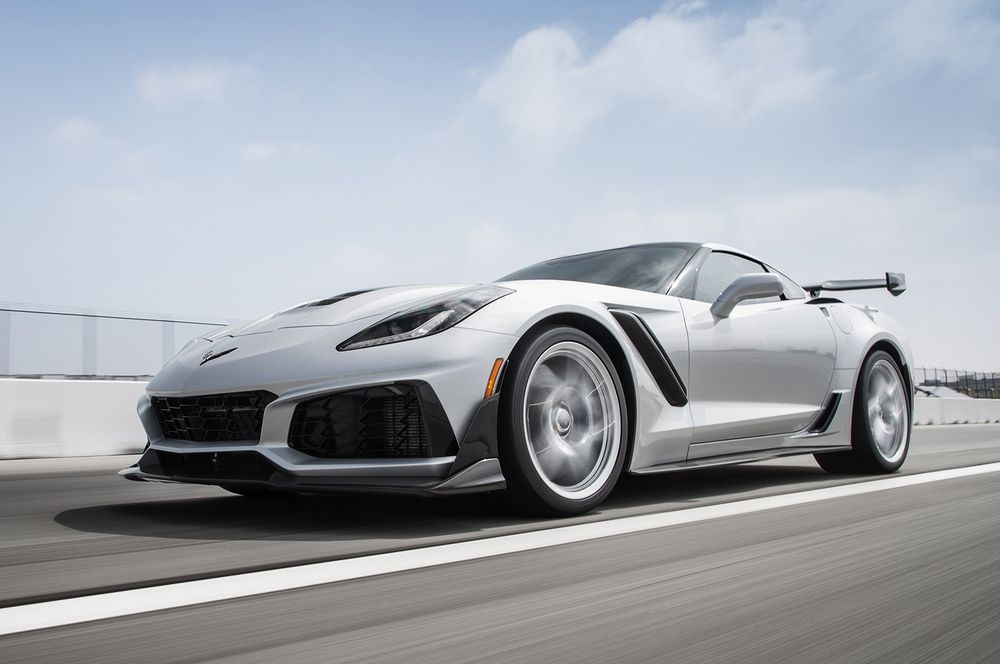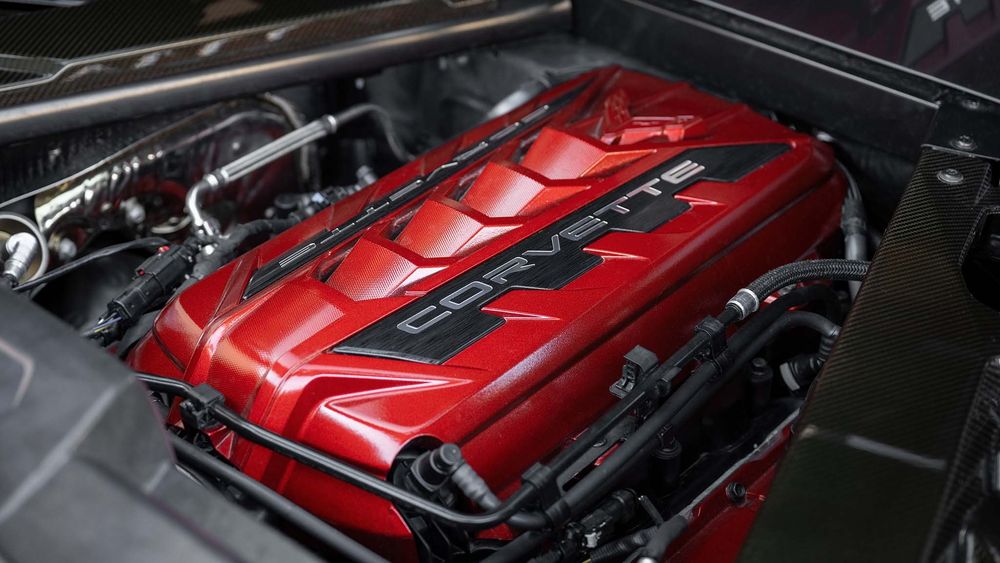The 10 Fastest Corvettes MotorTrend Has Ever Tested
These nasty Corvettes obliterated the quarter mile with a mix of power, technological know-how, and traction, traction, traction.
Any list of the fastest Corvettes is going to be heavy in the modern era, especially lately. The transition of the Corvette from a front-engine platform to a mid-engine model favors weight transfer in a way that improves traction off the line, thereby making it that much easier for the C8-generation Corvettes (introduced for the 2020 model year and a subsequent MotorTrend Car of the Year winner) to reach the all-time fastest podium.
0:00 / 0:00
But after wading through our decades of MotorTrend test data, we uncovered more than a few interesting outliers, including one stunner at the top of the heap, and several non-C8 cars. As it turns out, the mid-engine marvels of today aren’t the last word in outright Corvette speed, despite the quarter-mile yardstick we used to sort through its 70-plus years of American-born and -bred performance.
Before we get to the fastest ’Vettes, a quick note about our testing, Corvettes or otherwise: The MotorTrend test team measures the acceleration of more than 200 vehicles every year to inform the rigorous, unbiased reviews written by our experienced editors. To ensure our 0–60 and quarter-mile times are accurate and comparable, we hold ourselves to high standards. We test at automotive proving grounds in California and Michigan with Racelogic Vbox Touch data loggers that record a vehicle’s speed 25 times per second using high-accuracy GPS. All of our acceleration times are weather-corrected using the methodologies outlined by SAE International, the standards organization formerly known as the Society of Automotive Engineers. The weather correction defined in SAE J1349 allows MotorTrend acceleration numbers collected on a Michigan winter day to be directly compared with those captured during summer testing in California.
Now that you’re in the know about our vehicle testing expertise, here are the 10 fastest Corvettes MotorTrend has ever tested (for now at least, until we test the new 1,064-hp Corvette ZR1), along with each model’s claimed top speed number for good measure.
10. 2006 Chevy Corvette Z06 | 11.5 seconds at 127.1 mph
When the C6-generation Corvette arrived for the 2006 model year, it represented a significant step up in terms of performance. This was especially true for the Z06 edition, which swapped in a lighter all-aluminum frame compared to the base model, and also installed a 505-horsepower 7.0-liter V-8 under the hood (a 105-horsepower improvement over entry-level).
The Chevrolet Corvette Z06’s 470 lb-ft of torque is available over an incredibly fat slice of its powerband, with drivers treated to at least 80 percent of total output between 2,400 and 6,400 rpm on the way to the engine’s 7,000-rpm redline. All that grunt—plus its modest 3,147-pound curb weight—allowed practiced pilots to slip the clutch off the line and score a quarter-mile run of 11.5 seconds at 127.1 mph. That makes the 2006 Corvette Z06 quicker than the same-year Ferrari F430, which cost nearly three times as much.
Read our FIRST TEST of the 2006 Corvette Z06
9. 2021 Chevy Corvette Stingray | 11.4 seconds at 120.4 mph
Despite being heavier and not quite as powerful, the 2021 Chevrolet Corvette Stingray edges the old-school 2006 Corvette Z06 by a tenth of a second at the dragstrip. The secret? The C8 Stingray leverages a strong dose of high technology, including an eight speed twin-clutch automatic transmission and a computer-controlled launch system that wrings out every iota of traction when rocking off the line.
All the above, plus the natural traction-adding character of the Chevy Corvette Stingray’s mid-engine chassis placement (and the marvels of modern tire compounds) contribute to the car’s 495 horsepower overachieving in terms of straight-line speed. You’ll have to choose between acceleration and top speed, however: Z51 package cars are quicker thanks to their more aggressive gearing, but that slices their terminal velocity from the 198-mph rating on the base car to a still-exceptional 184 mph.
Read our LONG-TERM verdict and test of the 2021 Corvette
8. 2013 Chevy Corvette ZR1 | 11.4 seconds at 128.8 mph
The C6-generation Chevrolet Corvette ZR1—also known as the Blue Devil—was the most extreme version of the American sports car to date. Much of its extroverted personality came via its supercharged LS9 V-8 engine, which disgorged 638 horsepower and 604 lb-ft of torque from its 6.2 liters of displacement. Matched with a standard six-speed manual transmission, the 2013 Corvette ZR1’s output was enough to unsettle even the most experienced driver should they hit the hammer a little too hard on corner exit.
Despite the added heft of both a supercharger and copious amounts of aero, the 2013 ZR1 kept its weight manageable through the extensive use of carbon fiber in the construction of its body. Massive rear tires also helped plant the ZR1’s torque to the ground, allowing for a quarter-mile sprint of 11.4 seconds at 128.8 mph.
Read our COMPARISON TEST of the 2013 Corvette ZR1 and the SRT Viper GTS
7. 2015 Chevy Corvette Z06 | 11.2 seconds at 127.0 mph
The Corvette’s evolution has always incorporated the most successful elements of past models into even more potent replacement designs. So it goes with the 2015 Chevrolet Corvette Z06, a monster machine whose C7 platform pushed past what even the C6 ZR1 was able to accomplish in terms of speed and power.
It also helped that the revised Z06 benefited from an automatic transmission, a feature not available to either the Z06 or ZR1 models that preceded it. With better electronic traction management and quicker shifting, the eight-speed unit in the 2015 Corvette Z06 easily harnessed the 650 horsepower and 650 lb-ft of torque generated by its 6.2-liter supercharged V-8, leading it to a quarter-mile time of 11.2 seconds at 127.0 mph. Add the drag-inducing aero of the Z07 package to that same car, and you still get a remarkably similar (11.3 seconds at 126.2 mph) result.
Read our FIRST TEST of the 2015 Chevrolet Corvette Z06 Automatic
6. 2009 Chevy Corvette ZR1 | 11.2 seconds at 130.5 mph
The 2013 Chevrolet Corvette ZR1 was incredibly quick in our testing, so it only makes sense that the first-year model—which arrived in 2009—would also make it onto our list. With a quarter-mile time of 11.2 seconds at 130.5 mph, the first C6 ZR1 just ekes past the later edition with a higher trap speed (our tiebreaker) even though it’s a dead heat on the stopwatch.
Fun fact: The intercooler for the supercharger installed in the ZR1 is viewable through a transparent window in the hood, a styling cue that would be mimicked by the window found at the rear of the mid-engine C8 many years later.
Read our FIRST TEST of the 2009 Chevy Corvette ZR1
5. 2020 Chevy Corvette Stingray | 11.1 seconds at 123.2 mph
The first time we tested the Chevrolet Corvette Stingray (in 2020, the year it initially hit dealerships), it actually outperformed the 2021 edition. In fact, it did so by a respectable margin of 0.3 second in the quarter mile and 3 additional mph of trap speed.
Newer tires and even different drivers can account for these kinds of testing discrepancies. Continuing with the theme of varying results, it’s worth noting that we tested two other 2020 models that same year, with the 3LT Z51 edition of the car checking in with an 11.3-second quarter mile at 119.9 mph and a 1LT base model posting 11.5 seconds at 121.9 mph.
Read the FIRST TEST of the 2020 Chevy Corvette Stingray
4. 2019 Chevy Corvette ZR1 | 10.8 seconds at 133.1 mph
To one-up the over-the-top performance of the C7 Z06 Corvette, the C7 ZR1 had to reach stratospheres of power never sampled by Chevrolet’s longest-running sports car. In 2019 we got behind the wheel of the new Chevrolet Corvette ZR1 and were instantly impressed by the potential of its 755-horsepower 6.2-liter supercharged V-8, which quickly reset the record books for modern Corvette speed.
The deciding factor for the 2019 Corvette ZR1 versus the C6 ZR1 that came before it wasn’t just an increase in engine output (which was somewhat balanced out by the nearly 200 extra pounds of weight added to the party). The eight-speed automatic transmission that could be had with the model presented a computerized, quick-shifting, traction-seeking upgrade over the 6MT in the older ZR1. All told, it was enough to push the Corvette below the 11.0-second mark for the first time since the 1960s, with a posted quarter-mile time of 10.8 seconds at 133.1 mph.
Read the FIRST TEST of the 2019 Chevy Corvette ZR1
3. 2024 Chevy Corvette E-Ray | 10.6 seconds at 128.0 mph
Electrification seems inevitable for all performance car icons, and the Chevrolet Corvette is no exception. The E-Ray is the first-ever battery-assisted Corvette hybrid, which also marked another important performance-adding technology in the form of all-wheel drive. Taken together, the instant-on torque from its electric motor and the extra grip of its front axle have pushed the E-Ray well past many other Corvettes that are more gifted in the horsepower department.
The 2024 Corvette E-Ray managed a 10.6-second quarter mile at 128.0 mph in our testing, a figure made even more impressive by its nearly 4,000 pounds of curb weight. That’s nipping at the heels of the second-fastest Corvette we’ve ever tested.
Read the FIRST TEST of the 2024 Chevy Corvette E-Ray
2. 2023 Chevy Corvette Z06 Convertible 70th Anniversary | 10.6 seconds at 131.6 mph
What the E-Ray accomplishes with an extra powered axle and an electric motor, the 2023 Chevrolet Corvette Z06 convertible manages by way of exceptionally sticky tires and a trick launch control. By leveraging all the bits and bytes programmed into its eight-speed twin-clutch gearbox, the Z06 convertible dispatched the quarter mile in 10.6 seconds at 131.6 mph.
You’ll notice this beats the more powerful C7 ZR1 (with the C8 Z06’s 5.5-liter naturally aspirated V-8 producing 670 horsepower versus the C7’s 755 horsepower). The mid-engine design of the C8 cancels out a lot of drama at the starting line, and credit is also due to its mammoth Michelin Pilot Sport 4S ZP tires. Don’t think you’re giving anything up by going for the topless version of the C8 Z06, either, as testing the coupe with the Z07 package revealed an identical e.t. (with a slightly lower trap speed).
Read the FIRST TEST of the 2023 Chevy Corvette Z06 Convertible
1. 1969 Chevy Corvette ZL-1 | 10.6 seconds at 132.0 mph
Let’s be clear: The 1969 Corvette ZL-1 is a bit of a ringer. With its 550-horsepower 7.0-liter V-8 and its race-ready, sub-3,000-pound curb weight, the ZL-1 was an options package for the sports car that cost nearly as much as the coupe’s base price. It also came with a host of features designed specifically for track use, which is where this muscle machine was aimed.
Given its ferocious personality and eye-watering price at the time, it’s no surprise that only two Corvette ZL-1s ever made it into the hands of customers. When MotorTrend got its hands on one back in the day, we extracted a stunning 10.6-second quarter mile with a 132-mph trap speed, which to this day remains the fastest Corvette we’ve ever tested. Not bad for a vehicle whose only nod to high technology was the aluminum used to help keep its weight down.
Read the FIRST TEST of the 1969 Chevy Corvette ZL-1
A Couple More Corvettes, Just for Fun
1988 Chevrolet Corvette Callaway Sledgehammer | 10.6 seconds at 146.0 mph
Speaking of ringers—the Callaway Sledgehammer is without a doubt the gnarliest ’80s-era Corvette ever built. The goal of Callaway Cars was to produce an American missile that could chase down even the fastest European exotics at the top end, and it achieved this by way of a twin-turbo engine design available through any Chevrolet dealership as the B2K option at ordering time. Taken to its most extreme, Callaway eventually refined the B2K Corvette into the Sledgehammer.
The single-example Sledgehammer produced about 880 horsepower and 772 lb-ft of torque, a huge upgrade over the B2K’s 381 horses and 563 lb-ft. It also featured an aero-oriented body kit that helped it post a 10.6-second quarter mile with a trap speed of 146 mph, on its way to a top speed of 254 mph. The latter would stand for more than a decade as the pinnacle among street-legal cars.
1990 Chevrolet Corvette ZR-1 | 12.8 seconds at 113.8 mph
When Chevrolet sent the engine under the hood of the 1990 Corvette ZR-1 away to Lotus, it came back radically transformed. Featuring a 32-valve overhead quad-cam design in place of the standard pushrod setup, the 5.7-liter V-8 delivered 375 horsepower (and 400 horses in later models), which was rarefied air for the era.
Paired with a six-speed manual transmission, that was enough grunt to touch 12.8 seconds in the quarter mile, with a trap speed of 113.8 mph. To put that in context, that’s a full second faster than the same-year Acura NSX and an even greater gap versus the Ferrari 348, which cost nearly twice as much.

